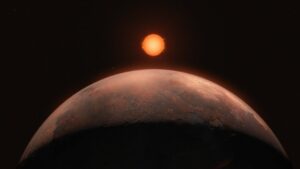Using the European Southern Observatory’s Very Large Telescope (ESO’s VLT), astronomers have detected a planet orbiting our solar system’s closest single star. Previous studies have found as many as five planets orbiting Earth’s closest stellar neighbors, a three-star system just over four light years away composed of Alpha Centauri A, Alpha Centauri B, and Proxima Centauri. However, some of those planets have yet to be confirmed.
This newly announced planet, dubbed Barnard b, is the first such world to have been found orbiting Barnard’s star, although a previous, unconfirmed detection of a planet orbiting Barnard’s star occurred back in 2018. At approximately six light years from Earth, this discovery makes it the closest planet to Earth that is orbiting a single star.
According to a statement from the ESO announcing the newly discovered planet, the astronomers responsible for finding Barnard b say it took five years of observations using the Paranal Observatory in Chile’s powerful VLT to confirm the planet’s existence. Still, the lead researcher says the team never doubted the value of their dedication.
“Even if it took a long time, we were always confident that we could find something,” explained Jonay González Hernández, a researcher at the Instituto de Astrofísica de Canarias in Spain and lead author of the paper.
Although unconfirmed, the team says its work also found signs of at least one more planet orbiting our solar system’s closest single star and “hints” of another two.
Observations of a Planet Orbiting Our Solar System’s Closest SingLe Star
In their published study, the researchers say they initially sought exoplanets orbiting within the habitable zone of Barnard’s Star. Astronomers and astrobiologists define the habitable zone as an orbital distance that would allow for the presence of liquid water on the planet’s surface. On Earth, liquid water is a critical ingredient for life, so scientists searching for life outside of Earth believe that habitable zone planets are a good place to look.
Unlike our sun, which is a G-type star, Barnard’s star is classified as a Red Dwarf. Most earth-like rocky exoplanets have been spotted orbiting Red Dwarf stars due to their much cooler temperatures than G-type stars. This cooler temperature results in less starlight, making the location of small, rocky worlds like Earth much easier than detecting similar planets around stars like our sun.


After five years of observation, the team says their efforts finally paid off. As expected, they discovered a planet orbiting our solar system’s closest star. The detection found that like many previously discovered exoplanets orbiting red dwarf star, Barnard b was extremely close to its host. In fact, the team says it is 20 times closer to its host than our Sun’s nearest planet, Mercury. As a result, the planet finished a complete orbit every 3.15 Earth days, making its orbital “year” less than 1% of Earth’s 365.25-day average.
Unfortunately, this proximity pushed Barnard b out of its star’s habitable zone. According to the researchers, its surface temperature is likely 125 °C.
“[T]he planet is too close to the host star, closer than the habitable zone,” explained González Hernández. “Even if the star is about 2500 degrees cooler than our Sun, it is too hot there to maintain liquid water on the surface.”
The star is also extremely low in mass, with estimates placing it at half the mass of Venus. If confirmed, this would make Barnard b one of the lowest-mass exoplanets ever discovered.
“Barnard b is one of the lowest-mass exoplanets known and one of the few known with a mass less than that of Earth,” said González Hernández.
Future Observations Could Confirm Existence of Three Additional Planets
Although most exoplanets are spotted using the “transit” method, where astronomers look for a regular dip in the star’s brightness every time a planet passes between the star and Earth, the confirmation of Barnard b was made using a method that measures the gravitational effect of a planet on its host star to deduce its existence. According to the ESO statement, “these observations were confirmed by data from other instruments also specialized in exoplanet hunting: HARPS at ESO’s La Silla Observatory, HARPS-N, and CARMENES.” Notably, these measurements ruled out the existence of the planetary candidate spotted back in 2018.
Still, the astronomers who discovered a planet orbiting our solar system’s closest star say their data did hint at the existence of as many as three more planets. While these detections are currently unconfirmed, the team says it aims to use the VLT’s powerful ESPRESSO instrument to see if any of those planetary candidates are real. And even if Barnard B is alone, they say its mere existence is cause for celebration by those hunting for smaller, rocky exoplanets that may support life.
“We now need to continue observing this star to confirm the other candidate signals,” explained Alejandro Suárez Mascareño, a researcher also at the Instituto de Astrofísica de Canarias and co-author of the study. “But the discovery of this planet, along with other previous discoveries such as Proxima b and d, shows that our cosmic backyard is full of low-mass planets.”
The study “A sub-Earth-mass planet orbiting Barnard’s star” was published in Astronomy & Astrophysics.
Christopher Plain is a Science Fiction and Fantasy novelist and Head Science Writer at The Debrief. Follow and connect with him on X, learn about his books at plainfiction.com, or email him directly at christopher@thedebrief.org.

